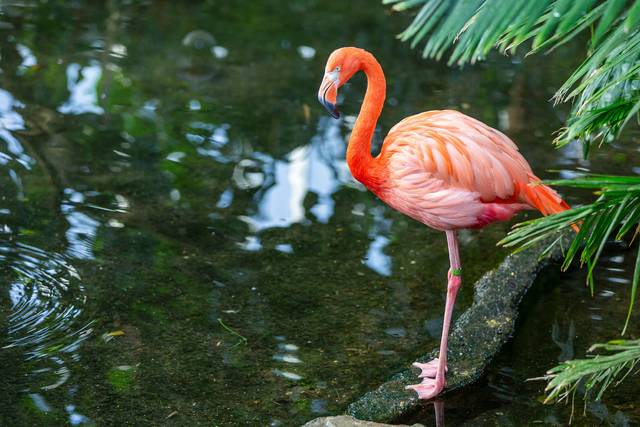In January, with the holidays behind us, the gray reality of winter sets in. It’s a time when many people dream of an escape to a tropical island paradise.
If that’s not in the cards this year, there’s a little piece of the tropics on Pittsburgh’s North Side that can make you forget about winter for a while. Even better, there’s no packing, planning or passport required. It’s the National Aviary — the nation’s only zoo dedicated to birds, and the only independent, indoor, nonprofit aviary — where “Escape to the Islands” is now open.
Enjoy the warmth of the National Aviary’s lush tropical habitats, which communications specialist Molly Toth says will be adorned with “tropical oasis-themed décor and bright pops of color,” including palm trees and vibrant florals for this special event.
“Island birds often have highly unique adaptations, like specially shaped beaks,” Toth says. “That’s because they evolve quickly to make the most of the resources around them.” “Escape to the Islands” will introduce visitors to some of the facility’s iconic tropical and wetlands bird species, with special activities planned for up-close-and-personal interactions.
The spotlight will be on these six island birds and one surprise “bonus” species:
1. African Penguin
“You usually don’t think tropics when you think of penguins, but most species are more suited to warmer water,” Toth says.
African Penguins are native to South Africa and can be found nesting, resting and feeding in the nutrient-rich waters surrounding 24 so-called “Penguin Islands” off the coast of South Africa and Namibia.
Observe and learn about members of this tuxedo-clad endangered species during Penguins on Islands at 1 and 4 p.m. daily.
2. Victoria Crowned Pigeon
Named for Britain’s Queen Victoria, the world’s largest pigeon species has vibrant blue feathers, a deep maroon-colored breast and a regal lace-like crest. The inquisitive species is native to New Guinea and surrounding islands.
Visitors will find them in the National Aviary’s Tropical Rainforest, where they will promenade during Royal Strolls at 11 a.m. and 3:30 p.m. daily. A staff member will guide them as the staffer walks and answers questions.
3. American Flamingo
Recognizable for their long, curved necks and long legs, flamingos are usually bright pink, but feathers can range from light pink to scarlet. They are native to the Caribbean and Galapagos Islands.
“They’re very iconic,” Toth says. “You see a flamingo, and you immediately know what it is.”
The National Aviary’s flock struts its stuff around the pools in the Wetlands habitat. A good time to observe them is at feeding time during the Flamingo Island Adventure at 11:30 a.m. and 2 p.m. daily, when the flamingos venture very close to the observation deck—you may have a chance to feed one!
4. Guam Rail
You’ll have to be quick to spot these small, flightless birds as they dart about the Tropical Rainforest habitat. They are quick runners and very active, Toth says — and they are also a National Aviary success story.
“Up until recently, the Guam Rail was considered to be extinct in the wild. Now it’s classified as critically endangered,” Toth says of the species that is native (as its name implies) to the U.S. island territory in the western Pacific Ocean.
In 1987, biologists rescued 21 remaining Guam Rails and transported them to protected breeding areas and U.S. zoos, including the National Aviary. Since then, the National Aviary has led the way in Guam Rail breeding, contributing more than 60 birds to the worldwide population, with more than half being released on islands near Guam. That’s more than any other U.S. zoo.
5. Nicobar Pigeon
“This bird has pretty, shimmery feathers that look like palm fronds,” Toth says. Its head is gray, its tail is bright white, and the rest of its plumage is metallic green.
Fairly large as pigeons go, it is native to the Nicobar Islands in the eastern Indian Ocean and to other islands across Southeast Asia. Among the Nicobar Pigeon’s claims to fame is that it is the closest living relative of the dodo, an extinct flightless bird native to the island of Mauritius in the Indian Ocean last sighted in the late 1600s.
The National Aviary’s Nicobar Pigeons can be spotted in the trees of the Tropical Rainforest.
6. Raggiana Bird-of-Paradise
The national bird of New Guinea is “famous for its elaborate dancing” mating ritual, Toth says.
The males dance to attract mates, showing off their long tail feathers, which complement their yellow crowns, emerald-green throats and reddish-brown bodies.
“We have a juvenile male in the Wetlands, and he’s just beginning to grow his long tail feathers and dance to show off for the female,” Toth says. “It’s pretty exciting.”
Bonus: Bats!
They’re furry rather than feathered, but the National Aviary’s Malayan Flying Foxes’ nearly 5-foot wingspan is nonetheless impressive, and now visitors can watch them spread their leathery wings.
“People have many misconceptions about bats, so they’re surprised to see that these flying foxes have really cute faces when they get a peek behind their wings,” Toth says of this large fruit bat species native to the Malay Peninsula and islands across Southeast Asia.
The flying foxes hang out in Canary’s Call and participate in a session called Hang With the Bats at 3 p.m. daily.
Plan your “Escape to the Islands” at the National Aviary in Allegheny Commons Park at 700 Arch St., Pittsburgh, by calling 412-323-7235 or visiting aviary.org.








